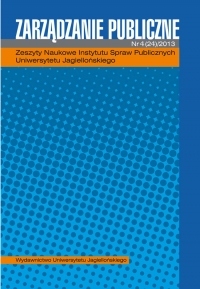The influence of inter-sector relationships on public resource allocation: Does the level of community deprivation count? An evaluation approach
The influence of inter-sector relationships on public resource allocation: Does the level of community deprivation count? An evaluation approach
Author(s): Beata Witek, Włodzimierz OkrasaSubject(s): Economy
Published by: Wydawnictwo Uniwersytetu Jagiellońskiego
Keywords: the third sector; public administrationl; resource spatial distribution
Summary/Abstract: This paper examines empirically a policy question whether or not there is a significant effect of the character of the relationships between the third sector organizations and public administration units for distribution of public resources at the local community level (gmina orcommunes). The key issue concerns the role of NGOs in making the level of community deprivation – measured by multidimensional index of local deprivation (MILD) – a factor in allocating resources to gmina (in the form of various subsidies accrued to it). An evaluation of the relative importance of the two competing criteria, equity andefficiency – which are typically, at least implicitly, involved in distribution of public resources – is conducted using public statistics data from the Bank of Local Data for years 2008 and 2010. Since it is usually assumed that the former remains of focus of the third sector units while the latter seems to remain under responsibility of the administration, one may expect that the type of relations between them will affect the prevalence of one of the two criteria over the others, without. however, knowledge of the circumstances conducive to it. Indeed, the results of empirical analysis reveal a clear pattern of the dependency –public resources obtained by gminas are shown to be on average both ‘need-adjusted’ and efficient when the relations are positive in character (however, not unconditionally – for instance, it is not true in the case of European Union’s funds). And that there is a form of complementarity between the above mentioned principles (equity and efficiency) under a certain pattern of interaction between non-profit organizations and administrative units at the local community – some of the circumstances suitable for such a desired type of effects are discussed in the paper.
Journal: Zarządzanie Publiczne
- Issue Year: 24/2013
- Issue No: 4
- Page Range: 419-435
- Page Count: 17
- Language: English

